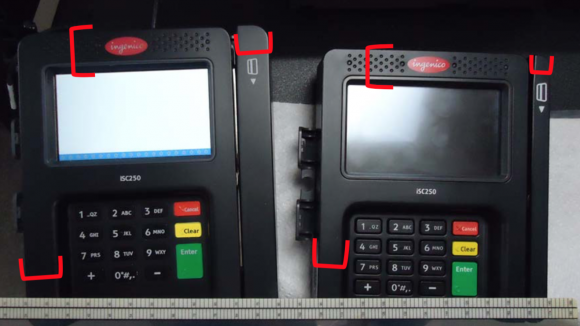Self-Checkout Skimmers Go Bluetooth
Exclusive: Volkswagen to pay $175 million to U.S. lawyers suing over emissions
October 14, 2016U.S. bans Samsung Galaxy Note7 smartphones from air travel
October 14, 2016
This blog has featured several stories about payment card skimming devices designed to be placed over top of credit card terminals in self-checkout lanes at grocery stores and other retailers. Many readers have asked for more details about the electronics that power these so-called “overlay” skimmers. Here’s a look at one overlay skimmer equipped with Bluetooth technology that allows thieves to snarf swiped card data and PINs wirelessly using nothing more than a mobile phone.
The rather crude video below shows a Bluetooth enabled overlay skimmer crafted to be slipped directly over top of Ingenico iSC250 credit card terminals. These Ingenico terminals are widely used at countless U.S. based merchants; earlier this year I wrote about Ingenico overlay skimmers being found in self-checkout lanes at some WalMart locations.
[embedded content]
The demo video briefly shows the electronics hidden on the back side of the overlay skimmer, but most of the sales video demonstrates the Bluetooth functionality built into the device. The video appears to show the skimmer seller connecting his mobile phone to the Bluetooth elements embedded in the skimmer. The demo continues on to show the phone intercepting PIN pad presses and card swipe data.
Your basic Bluetooth signal has a range of approximately 100 meters (328 feet), so theoretically skimmer scammers who placed one of these devices over top of a card terminal in a store’s self-checkout lane could simply sit in a vehicle parked outside the storefront and suck down card data wirelessly in real-time. However, that kind of continuous communication likely would place undue strain on the skimmer’s internal battery, thus dramatically decreasing the length of time the skimmer could collect card and PIN data before needed a new battery.
Rather, such a skimmer would most likely be configured to store the stolen PIN and card data until such time as its owner skulks within range of the device and instructs it to transmit the stored card data.
Concerned about whether the Ingenico terminals at your favorite store may be compromised by one of these overlay skimmers? Turns out, payment terminals retrofitted with overlay skimmers have quite a few giveaways if you know what to look for. Learn how to identify one, by checking out my tutorial, How to Spot Ingenico Self-Checkout Skimmers.
If you liked this piece, have a look at the other skimmer stories in my series, All About Skimmers. And if you’re curious about how card data stolen through skimmers like these are typically sold, take a peek inside a professional carding shop.

The red calipers in the image above show the size differences in various noticeable areas of the case overlay on the left compared to the actual ISC250 on the right. Source: Ingenico.
Thanks to Alex Holden of Hold Security LLC for sharing the above video footage.
Tags: Bluetooth, Ingenico, Ingenico self-checkout skimmer, Ingenico skimmer
This entry was posted on Friday, October 14th, 2016 at 4:02 pm and is filed under Other. You can follow any comments to this entry through the RSS 2.0 feed. You can skip to the end and leave a comment. Pinging is currently not allowed.
